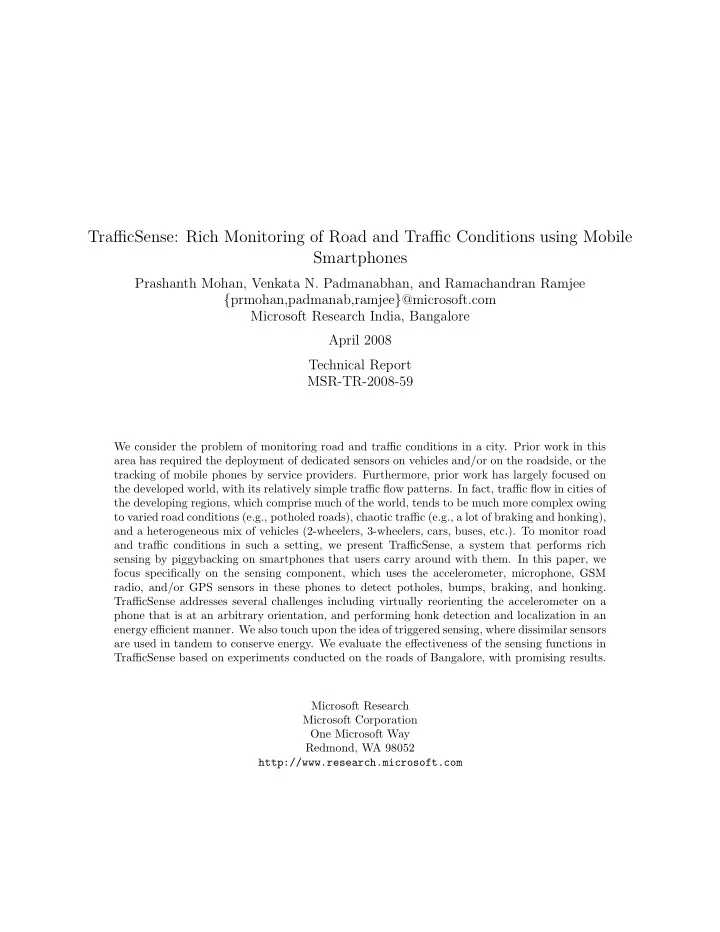

TrafficSense: Rich Monitoring of Road and Traffic Conditions using Mobile Smartphones Prashanth Mohan, Venkata N. Padmanabhan, and Ramachandran Ramjee { prmohan,padmanab,ramjee } @microsoft.com Microsoft Research India, Bangalore April 2008 Technical Report MSR-TR-2008-59 We consider the problem of monitoring road and traffic conditions in a city. Prior work in this area has required the deployment of dedicated sensors on vehicles and/or on the roadside, or the tracking of mobile phones by service providers. Furthermore, prior work has largely focused on the developed world, with its relatively simple traffic flow patterns. In fact, traffic flow in cities of the developing regions, which comprise much of the world, tends to be much more complex owing to varied road conditions (e.g., potholed roads), chaotic traffic (e.g., a lot of braking and honking), and a heterogeneous mix of vehicles (2-wheelers, 3-wheelers, cars, buses, etc.). To monitor road and traffic conditions in such a setting, we present TrafficSense, a system that performs rich sensing by piggybacking on smartphones that users carry around with them. In this paper, we focus specifically on the sensing component, which uses the accelerometer, microphone, GSM radio, and/or GPS sensors in these phones to detect potholes, bumps, braking, and honking. TrafficSense addresses several challenges including virtually reorienting the accelerometer on a phone that is at an arbitrary orientation, and performing honk detection and localization in an energy efficient manner. We also touch upon the idea of triggered sensing, where dissimilar sensors are used in tandem to conserve energy. We evaluate the effectiveness of the sensing functions in TrafficSense based on experiments conducted on the roads of Bangalore, with promising results. Microsoft Research Microsoft Corporation One Microsoft Way Redmond, WA 98052 http://www.research.microsoft.com
1 Introduction Roads and vehicular traffic are a key part of the day-to-day lives of people. Therefore, monitoring their conditions has received a significant amount of attention. Prior work in this area has primarily focused on the developed world, where good roads and orderly traffic mean that the traffic conditions on a stretch of road can largely be characterized by the volume and speed of traffic flowing through it. To monitor this information, intelligent transportation systems (ITS) [7] have been developed. Many of these involve deploying dedicated sensors in vehicles (e.g., GPS-based tracking units [9]) and/or on roads (inductive loop vehicle detectors, traffic cameras, doppler radar, etc.), which can be an expensive proposition and so is typically restricted to the busiest stretches of road. See [3] for a good overview of traffic surveillance technologies and Section 2 for related work. In contrast, road and traffic conditions in the developing world tend to be more varied because of various socio-economic reasons. Road quality tends to be variable, with bumpy roads and potholes being common- place even in the heart of cities. The flow of traffic can be chaotic, with little or no adherence to right of way protocols at some intersections and liberal use of honking. Monitoring such varied road and traffic conditions is challenging but it holds the promise of enabling new and useful functionality. For instance, information gathered via rich sensing could be used to annotate a map, thereby allowing a user to search for driving directions that would minimize stress by avoiding chaotic roads and intersections. To address this challenge, we present TrafficSense, a system for rich monitoring of road and traffic conditions that piggybacks on mobile smartphones. TrafficSense orchestrates the smartphones to perform sensing and report data back to a server for aggregation. Indeed, smartphones include a range of sensing and communication capabilities, in addition to computing. A phone might include any or all of a microphone, camera, GPS, and accelerometer, each of which could be used for traffic sensing functions. In addition, the phone would include a cellular radio (e.g., GSM), possibly with data communication capabilities (e.g., GPRS or UMTS). A mobile phone-based approach to traffic monitoring is a good match for developing regions because it avoids the need for expensive and specialized traffic monitoring infrastructure. Moreover, it takes advantage of the booming growth of mobile telephony in such regions. For example, as of late 2007, India had 209 million mobile telephony subscribers, growing at an estimated 7 million each month [12]. Although the majority of users have basic mobile phones today, a large number of them, in fact more than the number of PC Internet users in India, access the internet on their phones [8], suggesting that the prospects of greater penetration of more capable phones are good. There are similar growth trends in many other parts of the world, with the total number of mobile users worldwide estimated at 2.3 billion [13]. Note that despite being mobile phone-based, our approach to traffic monitoring is distinct from prior work based on remote tracking of mobile phones by cellular operators [1, 2, 34]. Our sensing and inferences goes beyond just monitoring location and speed information, hence requiring a presence on the phones themselves. Our focus in this paper is on the sensing component of TrafficSense; we defer a discussion of the larger system, including the aggregation server, to future work. Several technical challenges arise from our design choice to perform rich sensing and base the system on mobile smartphones. TrafficSense leverages sensors besides GPS — accelerometer and microphone, in particular — to glean rich information, e.g., the quality of the road or the noisiness of traffic. The use of an accelerometer introduces the challenge of virtually reorienting it to compensate for the arbitrary orientation of the phone that it is embedded in. Once the accelerometer is virtually reoriented, we need to design efficient and robust bump, brake and honk detectors in order to infer road and traffic conditions. Moreover, since a smartphone is battery powered and is primarily someone’s phone, energy-efficiency 1
Recommend
More recommend